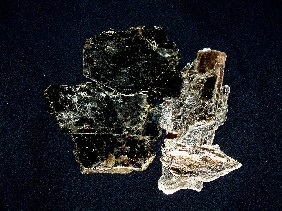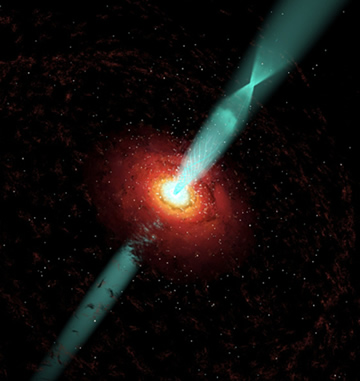This picture, created by an artist, shows the area near a supermassive black hole where jet of particles flow in spirals. Research suggests this pattern is due to twisted magnetic fields.
Click on image for full size
Image courtesy of Marscher et al., Wolfgang Steffen, Cosmovision, NRAO/AUI/NSF
Catching a Glimpse of a Black Hole's Fury
News story originally written on April 23, 2008
With the help of some powerful telescopes, a team of scientists has been spying on a black hole at the center of a galaxy that is 950 million light years from Earth.
This is not just any black hole. This is a supermassive black hole - millions of times more massive than the Sun. Jets of charged particles flow from it so fast that they nearly travel at the speed of light.
How these jets of charged particles work has been a mystery. To learn more about them, the team of scientists used the National Science Foundation's (NSF) Very Long Baseline Array (VLBA) and international telescope partners too. With these tools they could look at the clearest view ever captured of the innermost region of the black hole. They looked at an outburst of charged particles from the galaxy from late 2005 to 2006.
The images reveal evidence that the enormous jets of particles emitted by supermassive black holes form coiling patterns. The researchers believe the coiling is because the particles flow through twisted magnetic fields that are close to the black hole.
"This is a major advance in our understanding of a remarkable process that occurs throughout the Universe," said Alan Marscher of Boston University, leader of the research team.
Last modified May 8, 2008 by Lisa Gardiner.
You might also be interested in:

During the early 1900's, which is not very long ago, astronomers were unaware that there were other galaxies outside our own Milky Way Galaxy. When they saw a small fuzzy patch in the sky through their
...more
Scientists have learned that Mount Hood, Oregon's tallest mountain, has erupted in the past due to the mixing of two different types of magma. "The data will help give us a better road map to what a future
...more
The Earth's mantle is a rocky, solid shell that is between the Earth's crust and the outer core, and makes up about 84 percent of the Earth's volume. The mantle is made up of many distinct portions or
...more
Some geologic faults that appear strong and stable, slip and slide like weak faults, causing earthquakes. Scientists have been looking at one of these faults in a new way to figure out why. In theory,
...more
The sun goes through cycles that last approximately 11 years. These solar cycle include phases with more magnetic activity, sunspots, and solar flares. They also include phases with less activity. The
...more
Studying tree rings doesn't only tell us the age of that tree. Tree rings also show what climate was like for each year of a tree's life, which means they can tell us about climates of the past and about
...more
Earth's first life form may have developed between the layers of a chunk of mica sitting like a multilayered sandwich in primordial waters, according to a new hypothesis. The mica hypothesis, which was
...more















